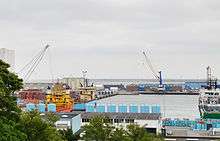Port of Esbjerg
The Port of Esbjerg on the southwest coast of Jutland is an important hub for passenger traffic to England and a competitor to Aarhus and Hamburg for freight. Built by the State in 1868, it was once Denmark's principal fishing harbour but today has become Europe's leading port for shipping offshore wind turbines.


History
Esbjerg was established in 1868 as a replacement for the harbour in Altona,[1] which had previously been Denmark's most important North Sea port but came under German control after the Second Schleswig War in 1864. The harbour was officially opened in 1874. The same year, it benefited from Esbjerg's rail connection to Fredericia on the east coast of Jutland.[2] The initial development of the harbour was completed in 1874. It quickly became a hub for exporting agricultural goods to England, especially butter and bacon. Thanks to the harbour's shipping facilities, by the end of the 19th century, livestock production in the surrounding region increased significantly.[3] From the beginning of the 20th century, Esbjerg attracted fishermen from across the country, particularly for fishing plaice.[4] Located some 25 km (16 mi), Blåvand Lighthouse has served traffic from the Port of Esbjerg since its construction in 1900.[5]
The Port of Esbjerg was administered by the State until 2000 when it became privately controlled under Esbjerg Municipality. Today it is one of the four largest ports in Denmark enjoying a central position in the region's infrastructure. In addition to container and passenger traffic, it has attracted fish-processing activities and marine repair work as well as a wide variety of supporting services.[3]
Passenger ferries
DFDS formerly operated an overnight ferry to Harwich in the south of England, taking about 12 hours. The service ended on 29 September 2014 after 140 years. A new ferry company has announced their intention to restart the service in April 2015, but by March 2017 no new ferry service has been opened.[6]
There were also ferry connections between Esbjerg and Newcastle but these have been discontinued.[7] Over the past few years (written 2014), the number of passengers using the port per annum has averaged 1.8 million.[8]
Harbour details
The Port of Esbjerg covers a total land area of 3.5 million m2 (1.35 sq miles), has 10 km (6.2 mi) of quays and an alongside depth of some 4.5 m (15 ft). The Tauruskay offshore wharf has a depth of 6.3 m (21 ft) while the bulk cargo Australienkaj, the Europakaj and the Vestkraftkaj for containers all have an alongside depth of 10.5 m (34 ft). The Englandskaj serving passenger traffic has a length of 310 m (1,020 ft) and an alongside depth of 7.6 m (25 ft) while the Færgehavn handling containers, passengers and ferries over a length of 420 m (1,380 ft) has an alongside depth varying from 4.4 m (14 ft) to 9.3 m (31 ft).[9] Other wharfs include the Humberkaj for frozen cargoes, the Containerkaj for roll-on, roll-off containerized cargoes and the Oliebro for liquid bulk carriers.[10]
In recent years, the port has handled some 4 million tons of cargo a year, of which some 500,000 tons have been liquid fuels.[8]
Offshore
Esbjerg has served the Danish offshore industry since oil and gas was first extracted from the North Sea in the early 1970s. More recently, it has become a centre for shipping offshore wind turbines. In addition to handling 65 percent of all Danish wind turbines (which now supply 3 GW of offshore wind power), the port has shipped components to various British wind farms. In order to cope with future increases in Danish offshore wind power, twelve companies including DONG Energy and Bluewater Energy Services are planning the establishment of a Green Offshore Centre in Esbjerg.[11] In this connection, in June 2013 the port was significantly expanded with the opening of the Østhavn (East Harbour) covering an area of 650,000 m2 (7,000,000 sq ft).[12] Further expansion started in 2017, including two roll-on/roll-off discharge facilities.[13]
See also
- Fisheries and Maritime Museum, Esbjerg, tracing the history of the region's fisheries and shipping
References
- Dansk litteraturs historie: 1870-1920. Gyldendal A/S. 2009. p. 14. ISBN 978-87-02-04184-2.
- "Esbjerg". Den Store Danske (in Danish). Retrieved 11 February 2014.
- "Esbjerg Havn" (in Danish). Kultur Styrelsen. Retrieved 12 February 2014.
- Søren Byskov. "Herring, cod and other fish". Kulturarv.dk. Retrieved 12 February 2014.
- "Blåvandshuk" (in Danish). Heritage Agency. 17 June 2013. Archived from the original on 4 October 2013. Retrieved 12 February 2014.
- "Ferry from Harwich - Esbjerg - Travel by Ferry to Denmark". DFDS Seaways. Retrieved 12 February 2014.
- "Kronprins Frederik". faergejournalen.dk. Retrieved 12 February 2014.
- "Statistics". Port of Esbjerg. Archived from the original on 22 February 2014. Retrieved 12 February 2014.
- "Port of Esbjerg: Port Commerce". Port Source. Retrieved 12 February 2014.
- "Port of Esbjerg: Port Commerce". Port Source. Retrieved 12 February 2014.
- Jan Aagaard. "An ocean of wind turbines - Green Offshore". Denmark.dk. Retrieved 11 February 2014.
- "New Østhavn will boost Port of Esbjerg growth potential". Port of Esbjerg. 21 June 2013. Archived from the original on 12 February 2014. Retrieved 11 February 2014.
- "Esbjerg kicks off port expansion". reNEWS - Renewable Energy News. 24 February 2017. Retrieved 26 February 2017.